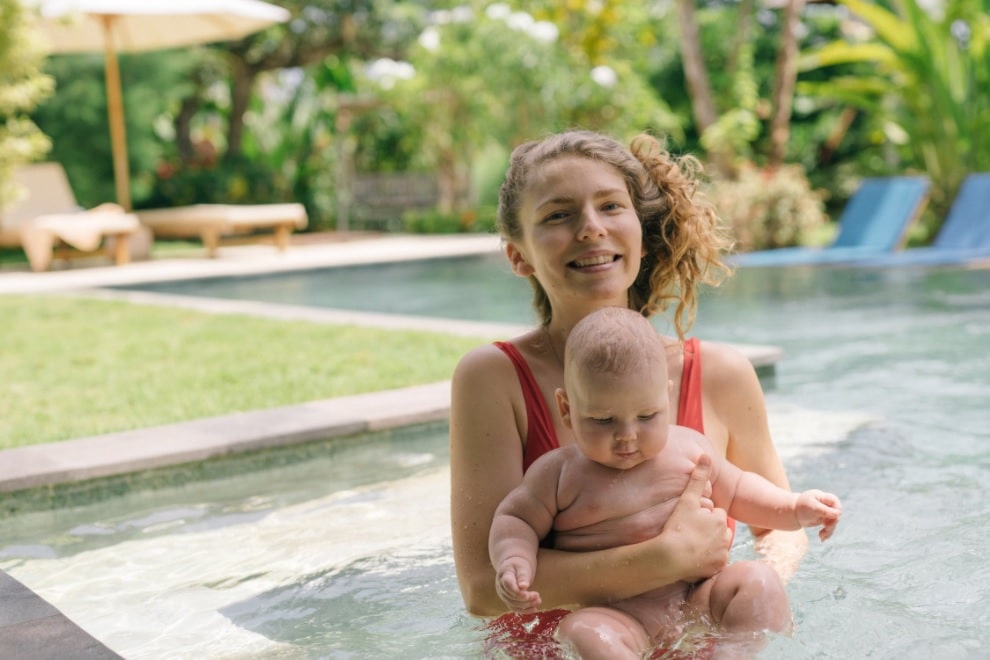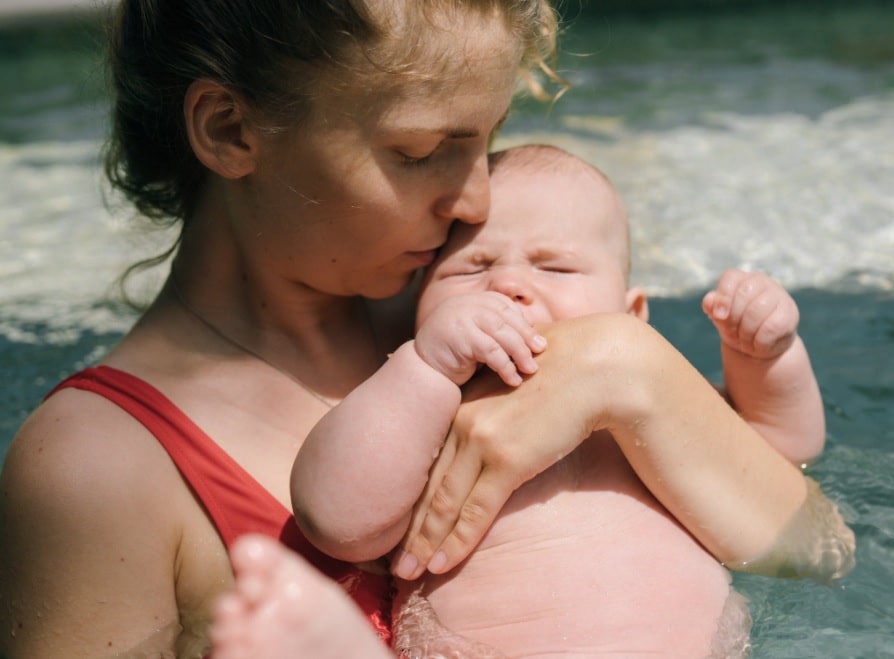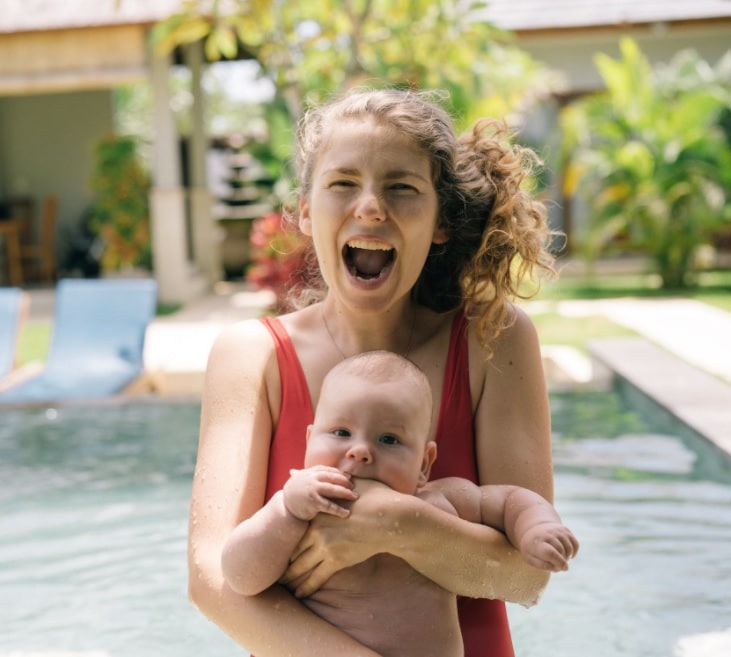You may or may not have heard but teaching babies to swim is of vital importance for their safety. According to the CDC, two children aged under 14 die everyday from unintentional drowning. So, you can understand that it is imperative to teach babies and kids to swim from an early age.
It is understandable that you may not be as familiar with the “learn to swim for kids” concept. And that, while interested in helping your kids do so, you don’t know where to start.
You may be great at getting all the appropriate swimming gear, like the best cooling towel, but are you confident in teaching babies and kids to swim? If you answered “no” you ought to start looking for a reputable teacher for your baby.
The earlier you begin the better as a child’s first swim can really define their future experiences in the water.
Before you book those first swim lessons let’s take a look at the physical benefits of teaching babies to swim.

Teaching Babies To Swim Will Improve Fine Motor Skills
Chasing a ball or grasping a pool noodle helps babies develop their fine motor skills. These are defined as “coordination of small muscles, in movements—usually involving the synchronization of hands and fingers—with the eyes.”
Starting young allows babies to develop dexterity. This will help them thrive in a host of other things as they grow older. Think school work and hand-writing, sports performance and creative arts.
Who would have thought that teaching babies to swim could have such positive effects later!
Coordination and Balance Benefit From Teaching Babies To Swim
Some say that kids who swim have it better when it comes to developing their balance and coordination. It’s easy to understand why.
Even if wearing a swim belt, swimming requires the coordinated movements of the arms and legs. This will vary in accordance with the different swimming strokes used.
By balancing their little bodies to maintain floatation, teaching babies to swim begins this important process. Moreover, coordinating their movements to successfully move through the water adds another important dimension. With enhanced coordination and balance, they ultimately achieve more milestones related to movement with ease.
Strengthen Babies Heart and Lungs Through Swimming
As you may know, swimming relies heavily on regulating breathing. This means that the heart and lungs play a major role in keeping a swimmer afloat. Not only that, teaching babies to swim also means them learning when to breath to not take water into their lungs.
When learning the principles of swimming, babies must first master the skill of holding their breath. This will increase lung capacity and help the body regulate oxygen usage.
When learning to swim, babies use their heart and lungs in a way they haven’t had to before. As a result, they “train” these two vital organs to become stronger. Might as well call these fierce little swimmers “target kids swim”, right?
Teaching Babies To Swim To Promote Muscle Development
You have a tiny muscle builder in your hands! That’s right – your baby’s rapid growth includes much needed development of its muscle system. It needs to become strong enough for the legs to support the body in order for your baby to be able to walk.
Teaching babies to swim has them performing all sorts of movement in the water. This means exerting energy in order to stay afloat and move through the water. Babies strengthen and build their muscle system in a fun and efficient manner.
Improve Appetite and Sleeping by Teaching Babies To Swim
If you have a baby that’s a poor sleeper or a picky eater, you have probably tried many things. We know a lot of tips and tricks to get them to follow a sleeping schedule or expand their palate.
This process can lead to a lot of frustration as these are two habits that can prove exceptionally hard to break.
Teaching babies to swim means having kids who usually love to get in the water. Swim kids spend considerable energy in the pool and their little bodies get tired. This means they will need to sleep soon after their workout to replenish their energy reserves.
The same applies for appetite and eating. You may notice that swim kids have an increased appetite. That’s because they have to make up for all the calories they burned while swimming. Increased appetite usually equates to less picky eaters.

Conclusion
Having read this article, you can understand why swim kids are perceived as strong for a reason.
In addition to the fact that teaching babies to swim can help prevent water accidents for children, it is also a fun activity. Furthermore, there are many physical benefits that have a long-term effect in a child’s development.
All in all, if you have been considering signing up your little one to swim lessons we encourage you to do some research. Find a reputable provider to help your baby become acquainted with water, and start swimming from an early age.
Let us know in the comments: Do you have a swim kid? Did you opt to get your baby into swim lessons as soon as you could? If so, why? What did you find as benefits of teaching your baby to swim?
My name is Andrea Thompson and I’m a home based freelance writer. I’m 23 years old, married to my best friend, and mother to a wonderfully independent and opinionated 3 year old girl and step-mother to a sweet seven year old boy. I live in a tiny, little town in Kentucky, where I spend my free time fishing with my kids.
Writing has always been my passion, which I followed through high school, and for a while in college. Life happened, and once I discovered we were pregnant, I switched directions; opting for the healthcare industry because of the stability.
Finally, years later, I was in a place where I could leave the day job that never truly made me happy, and pursue my dreams. I’ve built, and am still building, my writing career from scratch. But, I’m passionate and I’m good at what I do. And, in the end, I can prove to my daughter that she can do anything she wants with this life.





